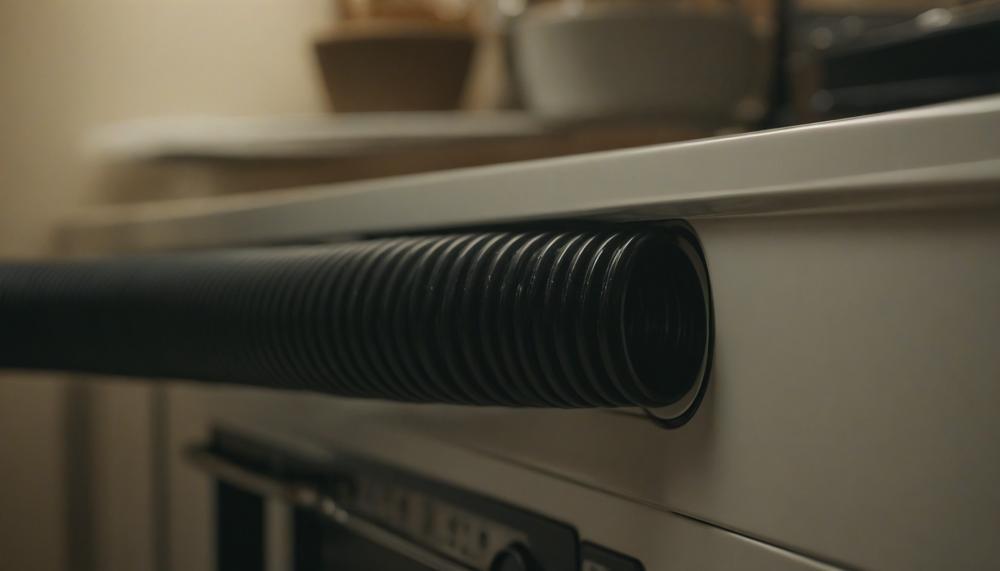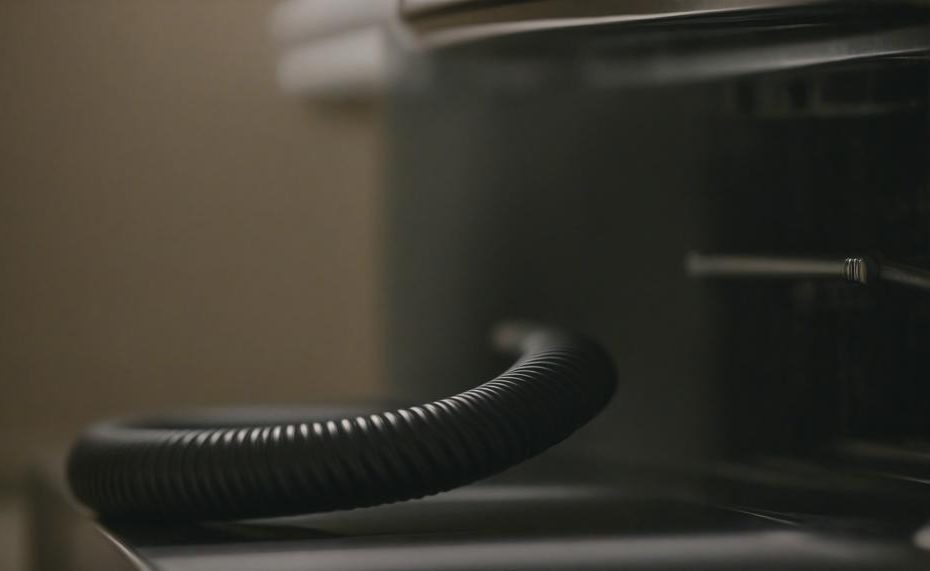Yes, you can shorten a dishwasher drain hose, and doing so can help ensure proper functioning and prevent potential water damage. A too-long drain hose can cause drainage issues, leading to water pooling or even backflow.
By shortening the hose, you can improve the efficiency and safety of your dishwasher setup.
Key Takeaways:
- Measure the exact distance between the dishwasher and the connection point.
- Cut the hose using a sharp tool, ensuring a precise and clean cut.
- Leave a little extra length to accommodate any movement.
- Secure the shortened hose with a clamp to prevent leaks.
- Ensure the hose is less than 10 feet long for optimal performance.
By following these steps, you can maintain a tidy and efficient kitchen environment. Shortening your dishwasher drain hose is a simple yet effective way to avoid potential drainage problems and enhance your dishwasher’s performance.
Contents
Why Do You Need to Shorten Dishwasher Drain Hose?
Shortening a dishwasher drain hose is crucial for several reasons. A properly sized drain hose ensures optimal water flow and prevents potential problems such as wastewater backflow, leaks, and improper drainage.
Key Reasons to Shorten a Dishwasher Drain Hose:
- Prevents Backflow: An excessively long drain hose can lead to water backflow, where dirty water re-enters the dishwasher. This backflow not only hampers the cleaning efficiency but also poses health risks due to potential contamination.
- Improves Drainage Efficiency: A shorter hose reduces the risk of kinks and bends that can obstruct water flow. Proper drainage is essential for maintaining the dishwasher’s performance and ensuring all wastewater is effectively removed.
- Reduces Leak Risks: Long hoses are more prone to developing leaks over time. Shortening the hose minimizes the chances of wear and tear, thus preventing potential water damage to your kitchen.
- Compliance with Manufacturer Guidelines: Manufacturers often recommend specific hose lengths for optimal performance. Exceeding these lengths can void warranties and lead to malfunction.
- Ensures Proper Installation: Shortening the hose allows for a more secure and tight connection. This is particularly important for creating a high loop that runs to the highest point beneath the sink, preventing siphoning issues.
How to Shorten a Dishwasher Drain Hose:
| Step | Description | Tools Needed |
| 1 | Measure the distance between the dishwasher and the tailpiece on the countertop/sink deck. | Measuring tape |
| 2 | Mark the hose to the desired length, leaving some extra room for movement. | Marker |
| 3 | Cut the hose carefully at the marked point. | Utility knife |
| 4 | Attach the shortened hose to the drain and secure it with a clamp. | Clamp, screwdriver |
| 5 | Create a high loop to prevent backflow. | — |
Required Items

To successfully shorten a dishwasher drain hose, you’ll need a few essential items. These tools and materials will ensure the process is quick, efficient, and effective.
| Item | Description | Purpose |
| Scissors or Sharp Knife | High-quality cutting tools | For cutting the hose to the desired length |
| Permanent Marker | Waterproof and non-fading | To mark the cutting points on the hose |
| Sandpaper | Medium grit (80-120) | To smooth out the cut edges of the hose |
| Duct Tape or Plumber’s Putty | Strong adhesive or sealing compound | To securely reattach and seal the hose after cutting |
| Measuring Tape | Flexible and accurate | For measuring the exact length to cut from the hose |
| Screwdriver | Flathead or Phillips, depending on your dishwasher model | To remove and replace the kick plate |
| Towel | Absorbent and large enough to cover the work area | To catch any water spills during the process |
Explanation:
- Scissors or Sharp Knife: These tools are crucial for cutting the hose to the exact length needed. Ensure they are sharp to make a clean cut.
- Permanent Marker: Use this to mark where you need to cut the hose. This ensures precision and helps avoid mistakes.
- Sandpaper: After cutting, smooth the edges with sandpaper to prevent any sharp edges that could cause leaks or damage.
- Duct Tape or Plumber’s Putty: These materials will help you securely reattach and seal the hose to prevent any leaks. Plumber’s putty can offer a more professional seal.
- Measuring Tape: Accurate measurement is key to ensuring the hose is cut to the right length, avoiding the need for adjustments later.
- Screwdriver: Necessary for removing and replacing the dishwasher’s kick plate, providing access to the drain hose.
- Towel: This will help you manage any spills and keep your workspace clean.
Remember to always unplug your dishwasher before starting any work to avoid electrical hazards. Regular maintenance of your dishwasher drain hose will ensure your appliance runs smoothly and efficiently.
10 Steps on How to Shorten Dishwasher Drain Hose
To successfully shorten a dishwasher drain hose, follow these detailed steps. Make sure you have all the necessary tools and materials at hand before starting the process.
| Step | Description | Details |
| 1 | Gather Necessary Items | Ensure you have scissors, duct tape or plumber’s putty, a permanent marker, measuring tape, sandpaper, a screwdriver, and a towel. |
| 2 | Turn Off Power | Unplug the dishwasher and turn off its power supply to avoid any electrical hazards. |
| 3 | Remove Kick Plate | Using a screwdriver, carefully remove the kick plate located at the bottom front of the dishwasher to access the hose. |
| 4 | Measure and Mark | Measure the desired length of the hose using measuring tape and mark it with a permanent marker where you need to cut. |
| 5 | Cut the Hose | Use scissors or a sharp knife to cut the hose at the marked spot. Ensure the cut is clean and straight. |
| 6 | Sand the Edges | Use sandpaper to smooth out the edges of the cut hose to prevent any leaks or damage when reattaching. |
| 7 | Reattach Connector | Reattach the connector to one end of the hose securely. Make sure it fits snugly to avoid leaks. |
| 8 | Snake the Hose | Carefully snake the shortened hose through the wall or cabinetry and into the dishwasher opening. |
| 9 | Secure the Hose | Fasten the hose in place using duct tape or plumber’s putty to ensure it remains secure and leak-free. |
| 10 | Check for Leaks | Before turning the power back on, check the hose for any signs of leaks. Turn the dishwasher on to ensure proper drainage. |
| 11 | Regular Maintenance | Regularly inspect the hose for wear or damage to ensure your dishwasher functions properly over time. |
Shortening your dishwasher drain hose may seem daunting, but by following these steps, you can ensure a smooth and efficient process. Remember to handle all tools carefully and prioritize safety throughout the task.
8 Maintenance Tips for Shortening a Dishwasher Drain Hose
When shortening a dishwasher drain hose, it’s crucial to ensure the task is done meticulously to maintain the appliance’s efficiency and avoid potential issues.
Unplug the Dishwasher
Always start by unplugging the dishwasher to avoid any electrical hazards.
Remove the Kick Plate
Detach the kick plate under the dishwasher to access the drain hose.
Measure Twice, Cut Once
Measure the distance from the dishwasher to the sink drain or garbage disposal.
Mark the hose where you need to cut, leaving some slack for flexibility.
Cut with a Sharp Tool
Use a box cutter or sharp knife to cut the hose at the marked point.
Ensure a clean, straight cut to prevent leaks.
Smooth the Edges
After cutting, smooth the cut edges with sandpaper to remove any burrs or sharp fragments.
Secure the Connection
Attach the shortened hose to the drain pipe using a hose clamp.
Make sure the connection is tight to prevent leaks.
Check for Leaks
Run a test cycle on your dishwasher to check for leaks.
Inspect the hose and connections carefully.
Regular Inspections
Periodically check the hose for signs of wear or damage.
Replace it immediately if you notice any cracks or leaks.
Conclusion
Shortening your dishwasher drain hose is a practical solution to avoid potential drainage issues and enhance your kitchen’s efficiency.
A long drain hose can cause backflow, pooling, and leaks, which can undermine the dishwasher’s performance and lead to water damage. Here’s a concise guide to safely shorten your dishwasher drain hose:
- Measure and Mark: Begin by measuring the distance between the dishwasher and the drain connection, allowing some extra length for flexibility. Use a permanent marker to mark where you’ll cut the hose.
- Cutting the Hose: Use a sharp utility knife to make a clean, precise cut at the marked spot. Ensure the cut is straight to avoid any leaks or fitting issues.
- Smooth the Edges: After cutting, use medium-grit sandpaper to smooth the edges of the hose, preventing any sharp points that could cause damage.
- Reattach and Secure: Attach the shortened hose to the drain connection, securing it with a clamp to prevent leaks. Make sure it fits snugly and is less than 10 feet in length for optimal performance.
- Create a High Loop: Form a high loop with the hose under the sink to prevent backflow, ensuring the wastewater flows out efficiently.
By following these steps, you’ll maintain an efficient, leak-free dishwasher setup. This straightforward adjustment not only improves drainage but also extends the life of your appliance.





